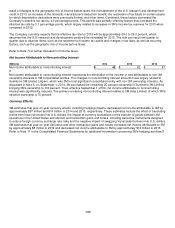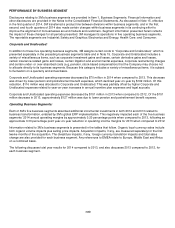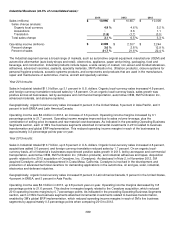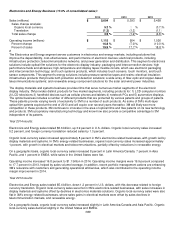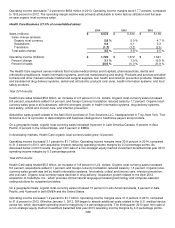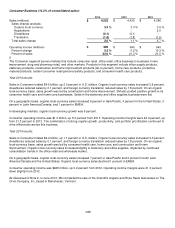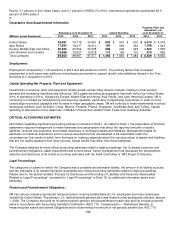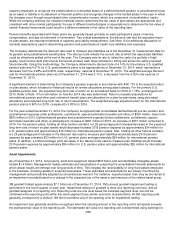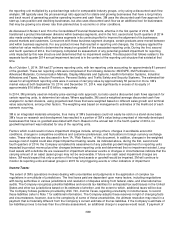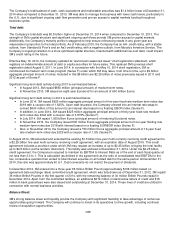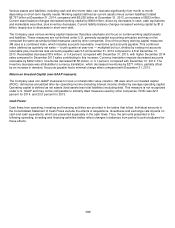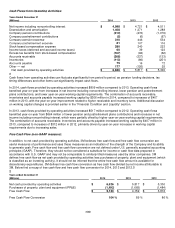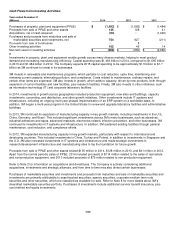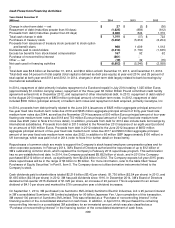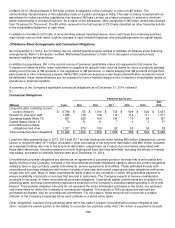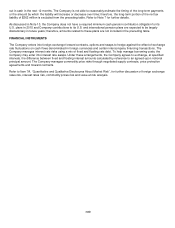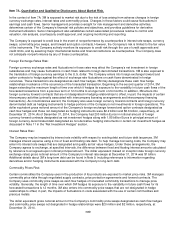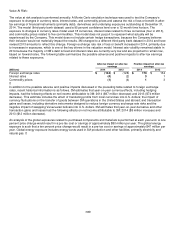3M 2014 Annual Report Download - page 40
Download and view the complete annual report
Please find page 40 of the 2014 3M annual report below. You can navigate through the pages in the report by either clicking on the pages listed below, or by using the keyword search tool below to find specific information within the annual report.34
the reporting unit multiplied by a price/earnings ratio for comparable industry groups, or by using a discounted cash flow
analysis. 3M typically uses the price/earnings ratio approach for stable and growing businesses that have a long history
and track record of generating positive operating income and cash flows. 3M uses the discounted cash flow approach for
start-up, loss position and declining businesses, but also uses discounted cash flow as an additional tool for businesses
that may be growing at a slower rate than planned due to economic or other conditions.
As discussed in Notes 3 and 15 to the Consolidated Financial Statements, effective in the first quarter of 2014, 3M
transferred a product line between divisions within business segments, and in the first, second and fourth quarters of 2014
also made certain changes within business segments in its continuing effort to improve the alignment of its businesses
around markets and customers. Concurrent with these business segment changes, certain products were moved between
and within business segments. For any product moves that resulted in reporting unit changes, the Company applied the
relative fair value method to determine the impact on goodwill of the associated reporting units. During the first, second
and fourth quarters of 2014, the Company completed its assessment of any potential goodwill impairment for reporting
units impacted by this new structure and determined that no impairment existed. The discussion that follows relates to the
separate fourth quarter 2014 annual impairment test and is in the context of the reporting unit structure that existed at that
time.
As of October 1, 2014, 3M had 27 primary reporting units, with ten reporting units accounting for approximately 81 percent
of the goodwill. These ten reporting units were comprised of the following divisions: 3M ESPE, 3M Purification Inc.,
Advanced Materials, Communication Markets, Display Materials and Systems, Health Information Systems, Industrial
Adhesives and Tapes, Infection Prevention, Personal Safety, and Traffic Safety and Security Systems. The estimated fair
values for all significant reporting units were in excess of carrying value by approximately 50 percent or more. 3M’s
market value at both September 30, 2014, and December 31, 2014, was significantly in excess of its equity of
approximately $16 billion and $13 billion, respectively.
In 2014, 3M primarily used an industry price-earnings ratio approach, but also used a discounted cash flows approach for
certain reporting units, to determine fair values. Where applicable, 3M used a weighted-average discounted cash flow
analysis for certain divisions, using projected cash flows that were weighted based on different sales growth and terminal
value assumptions, among other factors. The weighting was based on management’s estimates of the likelihood of each
scenario occurring.
3M is an integrated materials enterprise, thus many of 3M’s businesses could not easily be sold on a stand-alone basis.
3M’s focus on research and development has resulted in a portion of 3M’s value being comprised of internally developed
businesses that have no goodwill associated with them. Based on the annual test in the fourth quarter of 2014, no
goodwill impairment was indicated for any of the reporting units.
Factors which could result in future impairment charges include, among others, changes in worldwide economic
conditions, changes in competitive conditions and customer preferences, and fluctuations in foreign currency exchange
rates. These risk factors are discussed in Item 1A, “Risk Factors,” of this document. In addition, changes in the weighted
average cost of capital could also impact impairment testing results. As indicated above, during the first, second and
fourth quarters of 2014, the Company completed its assessment of any potential goodwill impairment for reporting units
impacted by product moves plus other changes between reporting units and determined that no impairment existed. Long-
lived assets with a definite life are reviewed for impairment whenever events or changes in circumstances indicate that the
carrying amount of an asset (asset group) may not be recoverable. If future non-cash asset impairment charges are
taken, 3M would expect that only a portion of the long-lived assets or goodwill would be impaired. 3M will continue to
monitor its reporting units and asset groups in 2015 for any triggering events or other indicators of impairment.
Income Taxes:
The extent of 3M’s operations involves dealing with uncertainties and judgments in the application of complex tax
regulations in a multitude of jurisdictions. The final taxes paid are dependent upon many factors, including negotiations
with taxing authorities in various jurisdictions and resolution of disputes arising from federal, state, and international tax
audits. The Company recognizes potential liabilities and records tax liabilities for anticipated tax audit issues in the United
States and other tax jurisdictions based on its estimate of whether, and the extent to which, additional taxes will be due.
The Company follows guidance provided by ASC 740, Income Taxes, regarding uncertainty in income taxes, to record
these liabilities (refer to Note 7 for additional information). The Company adjusts these reserves in light of changing facts
and circumstances; however, due to the complexity of some of these uncertainties, the ultimate resolution may result in a
payment that is materially different from the Company’s current estimate of the tax liabilities. If the Company’s estimate of
tax liabilities proves to be less than the ultimate assessment, an additional charge to expense would result. If payment of


